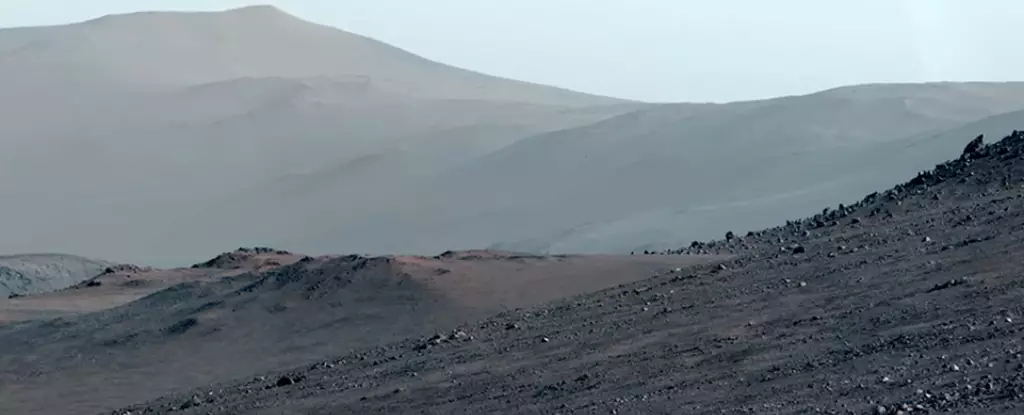In 2018, NASA’s mission planners made a pioneering decision to select Jezero Crater as the landing site for the Perseverance rover. This choice was far from arbitrary; the crater is a remnant of an ancient lake, characterized by a delta fan located at its western edge. Such geological formations on Earth commonly indicate sediment deposits laid down by flowing water—a clear sign of a once-water-rich environment. The delta’s composition, particularly its clay-rich deposits, accentuates Jezero Crater’s potential as a treasure trove for biosignatures, or remnants of life that may have thrived on Mars, either in the past or possibly even today.
Recent updates from NASA have confirmed that Perseverance reached the pinnacle of Jezero Crater’s rim, an area designated as Lookout Hill. After a three and a half-month ascent that involved climbing approximately 500 vertical meters and making various scientific observations along the journey, Perseverance is now poised to initiate its Northern Rim campaign. This ambitious next phase of the mission will see the rover traverse approximately 6.4 kilometers (about 4 miles), featuring up to four critical sites for geological sampling.
Since its landing in February 2021, Perseverance has embarked on four major science campaigns, yielding valuable information from different geological contexts within Jezero Crater. The rover’s initial campaign revolved around local features, including the intriguing Máz formation, where the vehicle collected numerous rock samples alongside atmospheric data vital for contaminant assessment. Following phases focused on distinct elements of the crater’s delta fan and the exploration of varying rock and clay compositions, culminating in the fourth campaign that examined carbonate rocks surrounding the crater’s upper edge.
The scientific team refers to the next phase as the Northern Rim campaign, a title reflecting the rover’s new venture into geology that has never been previously explored by Perseverance. Ken Farley, a project scientist for Perseverance at Caltech, emphasized the significance of this transition. The Northern Rim represents a shift from studying layers that formed at the crater’s bottom due to a massive impact, estimated to have happened around 3.9 billion years ago, to exploring rocks that originate from deep within Mars’s crust, uplifted during the same impact event. Investigating these ancient remnants can shed light on Mars’s formative years, permitting scientists to compare its geological history with that of Earth.
At Lookout Hill’s summit, Perseverance is now headed toward a prominent outcrop on the opposite side of the rim called Witch Hazel Hill. This location is remarkable for a layered structure that extends over 100 meters high. Each layer functions as a chronological record of Mars’s history, inviting researchers to delve into ancient environmental conditions as the rover descends the hillside. As noted by Candice Bedford, a scientist from Purdue University, this descent symbolizes a grand exploration of Mars’s past landscapes.
Beyond Witch Hazel Hill, Perseverance’s journey will lead it to Lac de Charmes, located on plains that lie beyond the crater’s boundaries. The scientific team finds this region particularly appealing, as it is less likely to have endured geological alterations from the impact that formed Jezero Crater. Following this exploration, the rover plans to return approximately 1.6 kilometers (1 mile) up the rim to investigate an outcrop comprised of megabreccia—remnants of ancient bedrock shattered by another significant impact event (the Isidis impact). This event, also estimated to have occurred 3.9 billion years ago, played a pivotal role in shaping Mars’s surface and the formation of the Isidis Planitia basin in the Northern Lowlands.
The study of these geological features promises insights into the Noachian period, a critical epoch in Martian geologic history characterized by extensive erosion from flowing water. During this time, river valley networks flourished, indicating that Mars might have once harbored conditions favorable for life, akin to the early Earth.
The overarching mission of Perseverance is to search for signs of past life during this “warmer and wetter” period. Through rigorous fieldwork, the rover aims to pinpoint biosignatures that could confirm Mars’s potential for life. During a recent media briefing at the annual American Geophysical Union meeting, Steven Lee, deputy project manager of Perseverance at NASA’s Jet Propulsion Laboratory, commended the ingenuity displayed by the rover team. These engineers have devised innovative strategies to navigate the challenging terrain encountered during the climb up the crater’s rim, demonstrating the adaptability and resilience of this extraordinary exploration mission.
In essence, Perseverance’s journey through Jezero Crater serves not only as a scientific endeavor but also as a narrative of our increasing understanding of Mars. As the rover continues its exploration, the prospect of unraveling the mysteries of Mars’s ancient environments and their potential to have harbored life remains firmly at the forefront of humanity’s quest for knowledge.


Leave a Reply